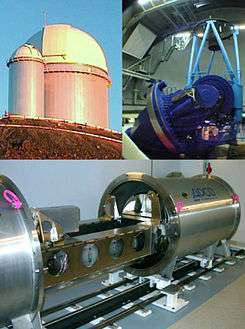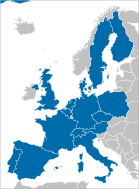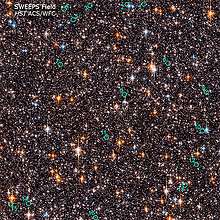
Montage of the HARPS spectrograph and the 3.6m telescope at La Silla. The upper left shows the dome of the telescope, while the upper right illustrates the telescope itself. The HARPS spectrograph is shown in the lower image during laboratory tests. The vacuum tank is open so that some of the high-precision components inside can be seen
The High Accuracy Radial velocity Planet Searcher (HARPS) is a high-precision echelle planet finding spectrograph installed in 2002 on the ESO's 3.6m telescope at La Silla Observatory in Chile. The first light was achieved in February 2003. HARPS has discovered over 130 exoplanets to date, with the first one in 2004, making it the most successful planet finder behind the Kepler space observatory. It is a second-generation radial-velocity spectrograph, based on experience with the ELODIE and CORALIE instruments.[1]
Characteristics
HARPS can attain a precision of 0.97 m/s (3.5 km/h),[2] with an effective precision of the order of 30 cm s−1,[3] making it one of only two instruments worldwide with such accuracy.[4] This is due to a design in which the target star and a reference spectrum from a thorium lamp are observed simultaneously using two identical optic fibre feeds, and to careful attention to mechanical stability: the instrument sits in a vacuum vessel which is temperature-controlled to within 0.01 kelvins.[5] The precision and sensitivity of the instrument is such that it incidentally produced the best available measurement of the thorium spectrum.[4] Planet-detection is in some cases limited by the seismic pulsations of the star observed rather than by limitations of the instrument.[6]
The principal investigator on HARPS is Michel Mayor who, along with Didier Queloz and Stéphane Udry have used the instrument to characterize the Gliese 581 planetary system, home to one of the smallest known exoplanet orbiting a normal star, and two super-Earths whose orbits lie in the star's habitable zone.[7]
It was initially used for a survey of a thousand stars.
Since October 2012 the HARPS spectrograph has the precision to detect a new category of planets: Habitable super-Earths. This sensitivity was expected from simulations of stellar intrinsic signals, and actual observations of planetary systems. Currently, HARPS can detect habitable super-Earth only around low-mass stars as these are more affected by gravitational tug from planets and have habitable zones close to the host star.[8]
Discoveries
This is an incomplete list of exoplanets discovered by HARPS. The list is sorted by the date of the discovery's announcement. As of December 2017, the list contains 134 exoplanets.
| HD 85512 b | 17 August 2011 |
| HR 7722 c | 17 August 2011 |
| HD 1461 c | 12 September 2011 |
| HD 13808 b | 12 September 2011 |
| HD 13808 c | 12 September 2011 |
| HD 20003 b | 12 September 2011 |
| HD 20003 c | 12 September 2011 |
| HD 20781 b | 12 September 2011 |
| HD 20781 c | 12 September 2011 |
| HD 21693 b | 12 September 2011 |
| HD 21693 c | 12 September 2011 |
| HD 31527 b | 12 September 2011 |
| HD 31527 c | 12 September 2011 |
| HD 31527 d | 12 September 2011 |
| HD 38858 b | 12 September 2011 |
| HD 39194 b | 12 September 2011 |
| HD 39194 c | 12 September 2011 |
| HD 39194 d | 12 September 2011 |
| HD 45184 b | 12 September 2011 |
| HD 51608 b | 12 September 2011 |
| HD 134606 d | 12 September 2011 |
| Nu2 Lupi b | 12 September 2011 |
| Nu2 Lupi c | 12 September 2011 |
| Nu2 Lupi d | 12 September 2011 |
| HD 150433 b | 12 September 2011 |
| HD 154088 b | 12 September 2011 |
| HD 157172 b | 12 September 2011 |
| HD 189567 b | 12 September 2011 |
| HD 204313 c | 12 September 2011 |
| HD 215152 b | 12 September 2011 |
| HD 215152 c | 12 September 2011 |
| HD 215456 b | 12 September 2011 |
| HD 215456 c | 12 September 2011 |
| Gliese 667 Cc | 21 November 2011 |
| HD 10180 i | 5 April 2012 |
| HD 10180 j | 5 April 2012 |
| GJ 3470 b | 22 June 2012 |
| Gliese 676 c | 29 June 2012 |
| Gliese 676 d | 29 June 2012 |
| Gliese 676 e | 29 June 2012 |
- Notes
- (a) — M sin i brown dwarf
- (b) — brown dwarf
- (c) — shorter period
See also

ESO 3.6-metre telescope is home to the world's foremost exoplanet hunter, HARPS.
[11]Similar instruments:
Space based detectors :
References
- ↑ Mayor; Pepe, F.; Queloz, D.; Bouchy, F.; Rupprecht, G.; Lo Curto, G.; Avila, G.; Benz, W.; Bertaux, J.-L.; et al. (2003). "Setting New Standards With HARPS" (PDF). ESO Messenger. 114: 20. Bibcode:2003Msngr.114...20M.
- ↑ "32 planets discovered outside solar system - CNN.com". CNN. 19 October 2009. Retrieved 4 May 2010.
- ↑ "ESPRESSO – Searching for other Worlds". Centro de Astrofísica da Universidade do Porto. 16 December 2009. Retrieved 2010-10-16.
- 1 2 citation needed
- ↑ "The exoplanet hunter HARPS: unequalled accuracy and perspectives toward 1 cm.s-1 precision" (PDF). ESO. Retrieved 14 September 2011.
- ↑ Carrier; Eggenberger, P; Leyder, J-C (2008). "Asteroseismology of solar-type stars: particular physical effects" (PDF). Journal of Physics: Conference Series. 118 (1): 012047. Bibcode:2008JPhCS.118a2047C. doi:10.1088/1742-6596/118/1/012047.
- ↑ Mayor; et al. (2009). "The HARPS search for southern extra-solar planets,XVIII. An Earth-mass planet in the GJ 581 planetary system". Astronomy and Astrophysics. 507 (1): 487–494. arXiv:0906.2780. Bibcode:2009A&A...507..487M. doi:10.1051/0004-6361/200912172.
- ↑ "An Earth mass planet orbiting Alpha Centauri B" (PDF). eso.org.
- ↑ "HARPS Sees Sunshine for the First Time". www.eso.org. Retrieved 18 May 2018.
- ↑ information@eso.org. "A decade of discoveries from HARPS". www.eso.org.
- ↑ "A Sparkling Ribbon of Stars — The Southern Milky Way over La Silla". ESO Picture of the Week. Retrieved 11 April 2013.








